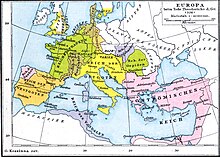Waostrogoti


Waostrogoti (yaani Wagoti wa Mashariki) walikuwa kabila la Kigermanik ambalo, pamoja na Wavisigoti, walichangia sana anguko la Dola la Roma na mwanzo wa Karne za Kati Ulaya.
Historia
[hariri | hariri chanzo]Wakitokea labda Uswidi, wanatajwa na waandishi wa Roma ya Kale kama wakazi wa beseni la Vistula (leo Polandi Kaskazini) katika karne ya 1. Baadaye walienea kwenye Bahari Nyeusi, walipowazidi Wasarmatia kama watawala wa Mbuga za Ponto wakaanza kushambulia maeneo ya Dola la Roma hadi Cyprus.
Wakati huo waligawanyika kati ya Wathervingi na Wagreuthungi. Miaka ya 300, Ermanariki, mfalme wa Wagreuthungi, alitawala kutoka Bahari ya Baltiki hadi Bahari Nyeusi, na Milima ya Urali. Wakati huo wengi wao waliingia Ukristo wa madhehebu ya Uario kwa umisionari wa Ulfilas, aliyebuni alfabeti ya Kigoti kuandika Biblia ya Kigoti.
Miaka ya 370 maeneo ya Wagoti yalivamiwa na Wahunni. Wagreuthungi wakakaa chini yao wakaja kuitwa Waostrogoti, kumbe Wathervingi, waliojulikana baadaye kama Wavisigoti, walivuka mto Danube na kuvamia Dola la Roma. Baada ya kunyanyaswa sana, waliasi na kushinda Warumi katika Mapigano ya Adrianopoli mwaka 378. Chini ya Alariki I, waliteka Roma yenyewe mwaka 410, na hatimaye wakalowea Galia na Hispania, walipounda Ufalme wa Wavisigoti.
Wakiungana na Dola la Roma Magharibi dhidi ya Wahunni wa Attila na Waostrogoti walipata ushindi kwenye Mapigano ya Uwanja wa Katalauni mwaka 451. Hapo Waostrogoti walijinasua katika utawala wa Wahunni wakavamia Italia mwishoni mwa karne ya 5 chini ya mfalme Theodoriki Mkuu, wakaanzisha Ufalme wa Waostrogoti.
Kidogo tu baada ya kifo cha Theodoriki (526), Italia ilitekwa tena (535–554) na kaisari wa Roma Mashariki Justinian I, lakini baada ya miaka michache Walombardi, wakitokea Skandinavia, waliteka Italia na kumeza Waostrogoti waliokuwa wamebaki.
Tanbihi
[hariri | hariri chanzo]Vyanzo
[hariri | hariri chanzo]- Amory, Patrick. People and Identity in Ostrogothic Italy, 489–554. Cambridge: Cambridge University Press, 2003. ISBN 0-521-52635-3.
- Backman, Clifford R (2008). The Worlds of Medieval Europe. Oxford and New York: Oxford University Press. ISBN 978-0-19-533527-9.
((cite book)): Invalid|ref=harv(help) - Bauer, Susan Wise (2010). The History of the Medieval World: From the Conversion of Constantine to the First Crusade. New York: W. W. Norton & Company. ISBN 978-0-39305-975-5.
((cite book)): Invalid|ref=harv(help) - Burns, Thomas (1984). A History of the Ostrogoths. Bloomington and Indianapolis: Indiana University Press. ISBN 0-253-32831-4.
((cite book)): Invalid|ref=harv(help) - Bury, J. B. (2000). The Invasion of Europe by the Barbarians. New York: W.W. Norton & Company. ISBN 978-0-39300-388-8.
((cite book)): Invalid|ref=harv(help) - Cantor, Norman F. (1994). The Civilization of the Middle Ages. New York: Harper Perennial. ISBN 0-06-092553-1.
((cite book)): Invalid|ref=harv(help) - Chisholm, Hugh (1910). The Encyclopædia Britannica: A Dictionary of Arts, Sciences, Literature and General Information. (Volumes 11-12). New York: Encyclopædia Britannica Inc.
((cite book)): Invalid|ref=harv(help)CS1 maint: location (link) - Collins, Roger (1999). Early Medieval Europe, 300–1000. New York: Palgrave Macmillan. ISBN 978-0-33365-808-6.
((cite book)): Invalid|ref=harv(help) - Dalby, Andrew (1999). Dictionary of Languages. New York: Columbia University Press. ISBN 978-0-23111-568-1.
((cite book)): Invalid|ref=harv(help) - De Puy, William Harrison (1899). The World-wide Encyclopedia and Gazetteer (vol 4). New York: Werner Co.
((cite book)): Invalid|ref=harv(help) - Encyclopædia Britannica, "Ostrogoth", stable URL: http://www.britannica.com/EBchecked/topic/434454/Ostrogoth
- Frassetto, Michael (2003). Encyclopedia of Barbarian Europe: Society in Transformation. Santa Barbara, CA: ABC-CLIO. ISBN 978-1-57607-263-9.
((cite book)): Invalid|ref=harv(help) - Halsall, Guy (2007). Barbarian Migrations and the Roman West, 376–568. Cambridge and New York: Cambridge University Press. ISBN 978-0-52143-543-7.
((cite book)): Invalid|ref=harv(help) - Heather, Peter (1996). The Goths. Oxford: Blackwell Publishers. ISBN 0-631-16536-3.
((cite book)): Invalid|ref=harv(help) - Larned, J. N., ed. (1895). History for Ready Reference. Cambridge, MA: C.A. Nichols.
((cite book)):|first=has generic name (help); Invalid|ref=harv(help)CS1 maint: multiple names: authors list (link) - Mierow, Charles Christopher (translator). The Gothic History of Jordanes. In English Version with an Introduction and a Commentary. 1915. Reprinted by Evolution Publishing, 2006. ISBN 1-889758-77-9.
- Oman, Charles W.C (1902). The Byzantine Empire. New York: G.P. Putnam’s Sons.
((cite book)): Invalid|ref=harv(help) - Todd, Malcolm (1999). The Early Germans. Oxford: Blackwell. ISBN 0-631-16397-2.
((cite book)): Invalid|ref=harv(help) - Waldman, Carl; Mason, Allan R. (2006). Encyclopedia of European Peoples. New York: Facts on File. ISBN 978-0-81604-964-6.
((cite book)): Invalid|ref=harv(help) - Wallace-Hadrill, J. M. (2004). The Barbarian West, 400–1000. Malden, MA: Wiley-Blackwell. ISBN 978-0-63120-292-9.
((cite book)): Invalid|ref=harv(help) - Wolfram, Herwig (1988). History of the Goths. Berkeley and Los Angeles: University of California Press. ISBN 978-0-52006-983-1.
((cite book)): Invalid|ref=harv(help) - Wolfram, Herwig (1997). The Roman Empire and its Germanic Peoples. Berkeley and Los Angeles: University of California Press. ISBN 0-520-08511-6.
((cite book)): Invalid|ref=harv(help)
Viungo vya nje
[hariri | hariri chanzo] media kuhusu Ostrogoths pa Wikimedia Commons
media kuhusu Ostrogoths pa Wikimedia Commons
| Makala hii kuhusu mambo ya kihistoria bado ni mbegu. Je, unajua kitu kuhusu Waostrogoti kama enzi zake au matokeo yake? Labda unaona habari katika Wikipedia ya Kiingereza au lugha nyingine zinazofaa kutafsiriwa? Basi unaweza kuisaidia Wikipedia kwa kuihariri na kuongeza habari. |
Text is available under the CC BY-SA 4.0 license; additional terms may apply.
Images, videos and audio are available under their respective licenses.
